“The Argonauts of the Universe” is a science fiction novel by Vladimir Vladko, which in its time raised more than one generation of science fiction fans. Nowadays, the novel, written in the 1930s in the Soviet Union about the realities of that time, is almost completely forgotten. However, we tried to look at it through the eyes of people living in Ukraine in 2024 and found something to tell you about it.
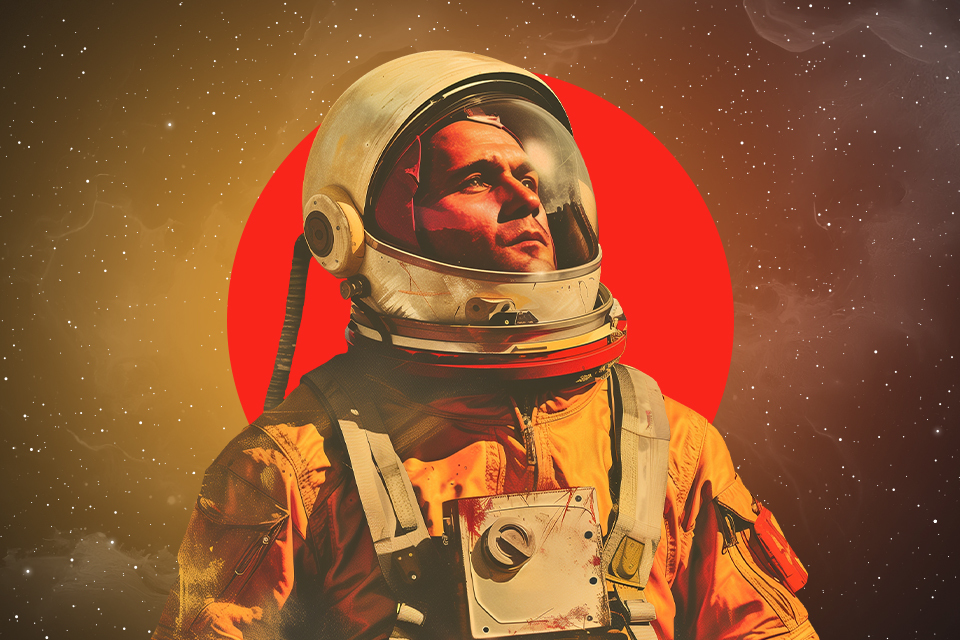
A flight to Venus
A futuristic spaceship with four astronauts, one of whom has secretly entered it, is flying to a distant planet. There, they want to find substances unseen on Earth, but extremely necessary for its industry. Upon landing, it turns out that the planet is overgrown with wild thickets inhabited by giant creatures, whom they often have to fight with firearms.
No, this is not a draft of a prequel to “Avatar” or even a “Starcraft” fanfic. This is the novel “Argonauts of the Universe” by Volodymyr Vladko, published in 1935, one of the first examples of space fiction in Ukrainian literature.
At the time of its publication, it was extremely popular because it was a space adventure quite on par with the best examples of what was being written in other countries at the time. However, gradually the ideas behind the book began to become outdated. And Vladko tried to modernize his novel.

The novel itself exists in at least two editions, which differ significantly from each other: the original, which was published several times in the 1930s, and the revised one, which was created in the 1950s. They differ mainly in technical details and some characters.
And while the first change is more or less understandable clear (after all, the 20 years between the two editions of the novel saw a significant leap in the development of technology), the characters need to be discussed separately.
Is it interesting to read The Argonauts of the Universe now?
Summarizing what I have written, we can think about the question of what would interest a reader in “The Argonauts of the Universe” today? First of all, this is an answer to those people who say that there were no themes other than unhappy peasants in Ukrainian literature until the time of independence.
Vladko wasn’t even the first Ukrainian science fiction writer, but it is “The Argonauts of the Universe” that makes us feel that the idea of space travel has been alien to Ukrainians for several generations.

“The Argonauts of the Universe” is interesting as a monument to the very type of thinking that existed in the early twentieth century. Back then, people did not realize that engineering activities could ruin the climate, and the idea of progress, under certain conditions, leads to the loss of ancient culture. We usually think of these trends as Soviet, but when young Vladko wrote his book about the flight to Venus, they were prevalent all over the world.
Only in the Soviet Union did they linger, and new gigantomaniacal projects to rebuild nature were being developed here even as the rest of the world began to clean up the consequences of the previous ones. Although who knows if something important was lost in the process.
“The Argonauts of the Universe” can still explain in a popular way to everyone some things that are obvious to astronauts but seem too complicated for the rest of us.
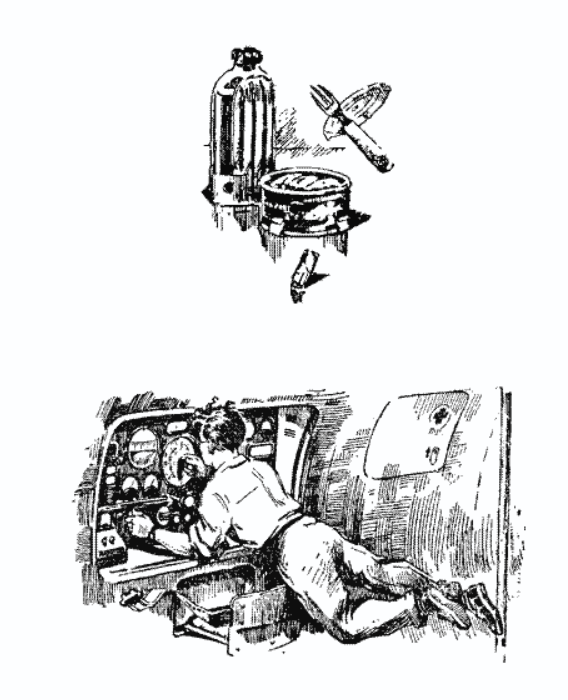
As for the main purpose of the book, which is to entertain, it can only be recommended to fans of the genre who read everything in it. And the point here is not that there are a lot of explanations. In fact, they are interesting to read. But the adventures themselves seem too simple now. Although it is possible that someone will like them as they are.
Communist propaganda
Another thing that one cannot help but notice while reading the book is communism. The book was written in the Soviet Union, and the author did not even try to hint that he was against this ideology. No, when the heroes are busy having adventures, for example, slowing down near Venus or traveling through its thickets, they do not mention constantly that they were sent by the “country of workers and peasants.”
However, as soon as one of the travelers (Rindin) opens his mouth about why they came there in the first place and why they were the first in the world to build a spaceplane, outright propaganda starts pouring out. He tells, that the Soviet Union was a country of light, and no one had heard of any repressions or mass starvation (the first edition was published two years after the Holodomor).
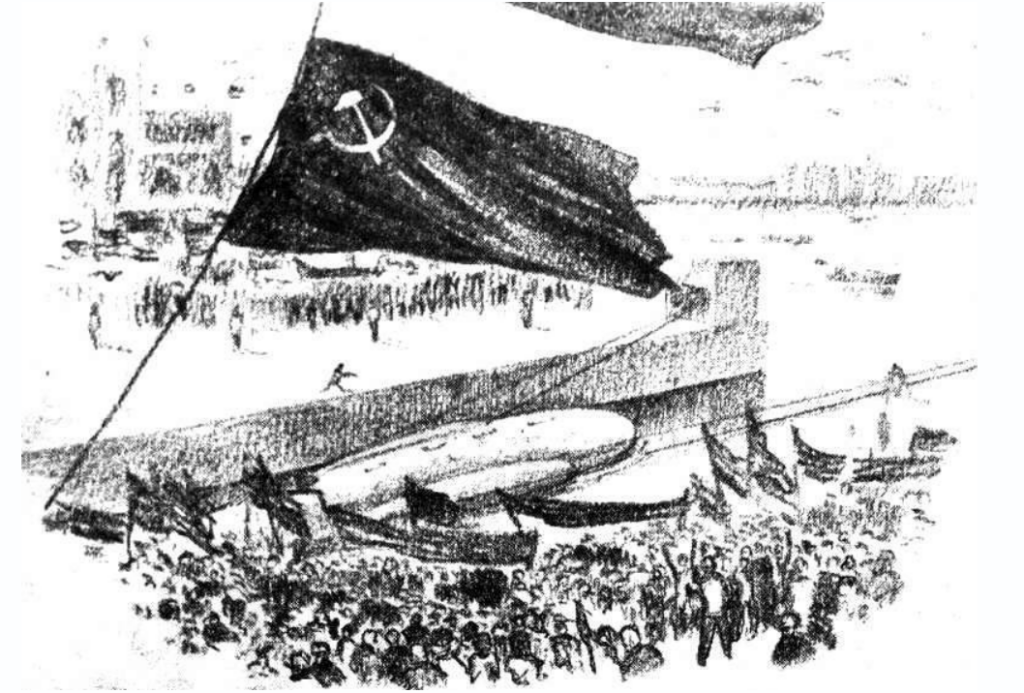
And the whole Earth is holding its breath, watching what an advanced country it is, and even the fact that they will be able to “fight nature violently to get its secrets” is closely connected in Rydin’s speech to the fact that they are communists.
The opening and closing scenes of the book now seem not even to be Soviet propaganda, but rather a parody of it. Because they depict with incredible pathos how special trains bring representatives of workers and peasants, members of the party and government from all over the Soviet Union to escort travelers into space and then greet them upon their return. You can simply skip these scenes, they are not important for understanding the main plot.
The Venus-1 rocket ship
The strong point of Vladko’s work is its scientific and technical component in the part about space travel. Here, the novel was clearly written as the most realistic science fiction possible. In some respects, it failed, but in others, it is still interesting to read as a popular presentation of the realities of space flight.
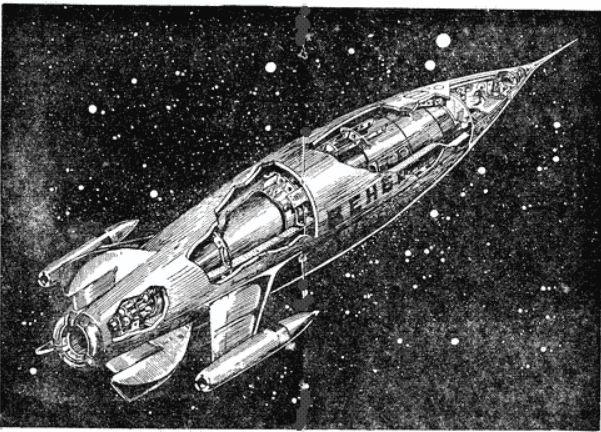
First of all, the “Venus-1” spacecraft, on which the characters travel, looks interesting. Vladko describes its scheme in great detail, and tries to achieve the level of engineering realism that Jules Verne had, for example, in his description of the “Nautilus” in “Twenty Thousand Leagues Under the Sea”. Even in the best examples of science fiction of the time, this was rare.
“Venus-1” is a real spacecraft with jet engines. It accelerates not because of a mysterious new engine, but simply throws out chemical reaction products in the opposite direction to the one it needs to go.
At the same time, Vladko clearly knows that it will not be possible to take off from the Earth’s surface on ordinary chemical fuel, as his characters do. In the first editions, they did it as a hydroplane, from the surface of a lake, and in later editions, from a long overpass on a jet cart.
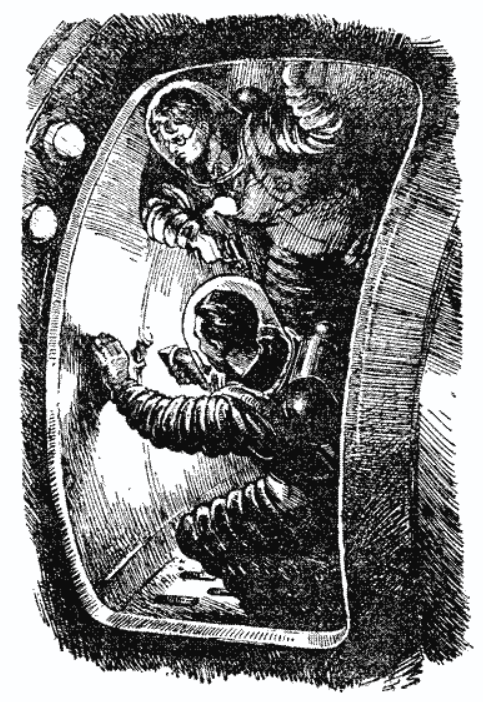
That’s why Vladko describes in some detail that the “Venus-1” is essentially an explosive airplane. In the early versions, the fuel is a fictional “supertroil”, which is fed in “tablets” to a special chamber in the engine, where it is detonated. The explosion causes the gases to expand much faster, and thus produces a higher specific impulse.
In later editions, Vladko describes in detail this problem, which is one of the central issues for modern space engine developers. The low rate of gas outflow means that almost the entire mass of the rocket at the time of launch must be fuel. In the 1950s version, “Venera-1” explodes nuclear fuel rather than conventional fuel in its engine chambers.
Vladko even gives a figure for the amount of gases escaping from the nozzle. It is quite close to those obtained for very real nuclear aircraft projects that have been developed in recent decades. However, the author quite rightly shows that even in this case, the “Argonauts” will fly inside two tiny cabins that are attached to a giant nuclear bomb storage facility.
By the way, this concept is quite real. The “Orion” project, developed in the United States in the 1950s, was supposed to accelerate by detonating atomic charges next to it. Although it was recognized as unpromising at the time, its descendants still appear from time to time.
Volodymyr Vladko’s outer space
Another feature of the “Venus-1” engine is that it does not work during the entire flight. It is turned on at the start to propel the spacecraft beyond the Earth and allow it to reach a speed of 11.5 km/s. This is indeed the so-called escape velocity for the Earth, the lowest at which a craft can overcome its gravity.
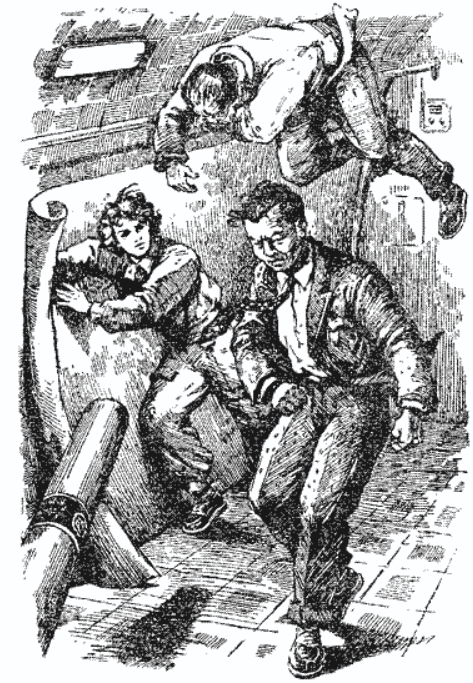
It is worth noting that at the time of writing the novel, humanity had not yet created a single vehicle that would move in this way: first accelerate and then fly for weeks without losing speed with the engines turned off. And in this respect, the “Argonauts of the Universe” was truly ahead of its time.
Another thing that you still pay attention to in the novel is weightlessness. The first time a person felt it in Earth orbit was only 25 years after the first version of the novel was published. Although this effect was known several centuries before, science fiction writers, even in his time, usually did not care to describe it in detail.
But Vladko described all of its effects quite accurately, up to the point that in microgravity you shouldn’t hit the table with your fist if you don’t want to hit your head on the thing above it. And the characters are as excited catching a drop of liquid with their mouths as modern astronauts on the ISS are.
What the novel describes accurately
Another detail that is interesting to read even now is the story of the flight trajectory between Earth and Venus. Vladko described it very accurately and even included a diagram in the book. In this way, The “Argonauts of the Universe” is very similar to Max Kidruck’s “The Colony”, published almost 90 years later. However, the second book explains why it is not easy to fly to Mars, but not to Venus.
Vladko explains in a very popular way, using simple calculations, that at the speed of the “Venus-1”, the shortest route to the neighboring planet would not be a straight line connecting the two celestial bodies at the point of their maximum convergence, but rather an ellipse arc, which requires an accurate calculation of the time of departure from Earth. The writer does not use the term “launch window,” but actually gives a definition of it.
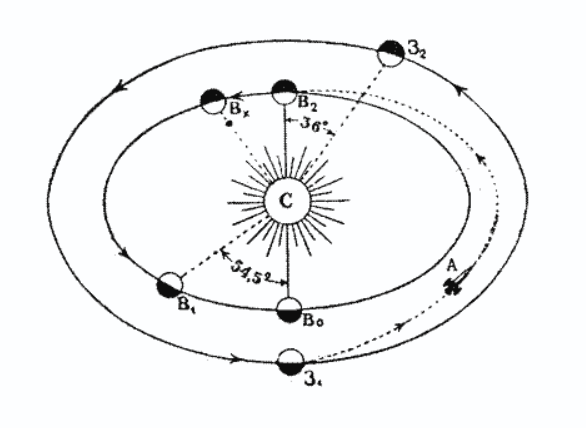
Another scientific aspect of the trip that Vladko conveys quite accurately is the braking maneuvers near Venus. Most science fiction authors even for decades after “Argonauts of the Universe” would forget that a spacecraft will actually have to perform them.
And even now, if an author mentions that a spacecraft has to do this, it is already a claim to science fiction. Vladko describes this maneuver in detail, although at his time all this was purely theoretical.
“Venus-1” approaches the planet of the same name tangentially, without slowing down. To brake, it uses a combination of engine momentum and aerodynamic braking. From a scientific point of view, the crew members are doing the right thing if we assume that their main goal is to save fuel. The planet’s atmosphere does everything for them.
Vladko is absolutely right to describe that after this maneuver, the orbit becomes an ellipse around Venus, and the braking point is its pericenter, the lowest point. And the braking that occurs after each revolution at the same point lowers not the orbit, but the apogee, the highest point of the orbit.
However, whether consciously or not, Vladko forces his characters to make a mistake that real astronauts near an alien unexplored planet would never make. The orbit they acquired after braking was too close to the planet, and the friction of the atmosphere finally slowed Venus-1 down, causing it to crash to the surface in a random location.
Instead, the heroes should have stayed in a higher orbit, properly examined the surface looming from behind under the clouds, and chosen a better place to land. However, their adventures on the surface would not have been as exciting.
Technical errors and inaccuracies
For all his talent, Volodymyr Vladko made a lot of inaccuracies in the novel, or even simply relied on false theories. One of the most unrealistic moments of the novel is the lack of radio communication between the crew and the Earth. In the novel, this is explained by the presence of the “Heaviside layer,” which at the time was considered by many to be impervious to electromagnetic waves because the long waves that were the basis of radio communication at the time were well reflected from the lower layers of the ionosphere.
Of course, in reality, the ionosphere retains only a part of radio waves, and the rest passes through it without any problems. And this was pointed out to the author at the time of writing the novel. So in newer editions, they maintain contact with the Earth, at least during the first stages of the flight. But then they lose it, this time due to cosmic rays.
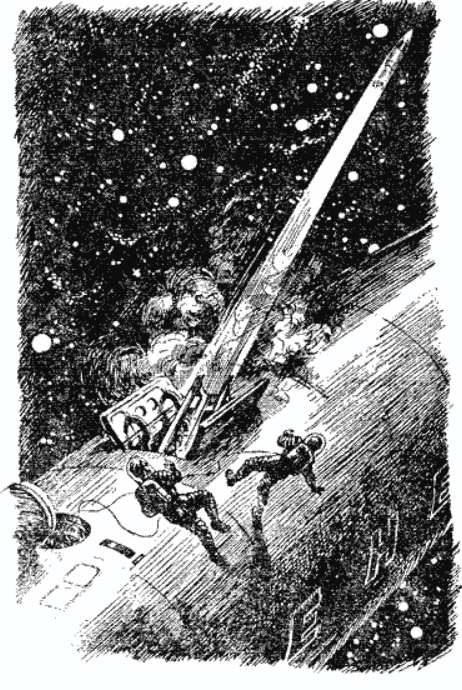
It seems that the author needed this in order to introduce a device that is extremely ambiguous from a scientific point of view: the mail rocket. A small rocket in which the “Argonauts” put a handwritten message to their compatriots and launch it to Earth. There are four such devices on Venus-1, and in order to launch the first one, one of the crew goes outside the ship in a spacesuit.
The spacesuit itself, and the description of the spacewalk, and the hero’s feelings during it are very well described. However, this does not negate the senselessness of this action. Vladko seems to forget everything he had written about celestial mechanics before. A postal rocket would have to use an incredible amount of fuel, because at the beginning it has the same velocity vector as a spacecraft. And it is extremely difficult to correct it by accelerating it so that it gets to Earth.
Even stranger is the later launch of such a rocket from the surface of Venus. Here, Vladko forgets about the need to overcome the gravity of the planet. And, judging by the description, it is not launched during the launch window at all.
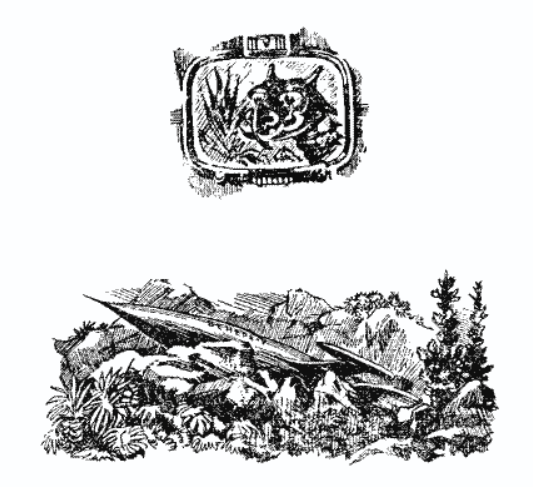
Another obvious mistake that Vladko made in the early version of the novel was the generation of electricity on the ship. For this purpose, he proposed to use the movement of water in the pipes caused by the temperature difference on the illuminated and shaded sides of the rocket.
The nonsense here is not that “Venus-1” most likely rotated on its axis and there was no permanently shaded area. The point is that there shouldn’t have been such a difference on a metal ship in principle. Space is not cold in itself, especially at distances from the Sun less than the Earth’s orbit. A vacuum has no temperature, and energy losses in it are determined by radiation from the surface, which is usually so inefficient that modern vehicles with powerful propulsion systems have to be equipped with radiators.
Moreover, the thermal conductivity of the metal case would not allow for a significant temperature difference. Perhaps that is why Vladko abandoned this idea in later versions of the novel in favor of solar panels. And he describes the principle of their work very accurately.
Venus
However, modern readers’ main complaint about The “Argonauts of the Universe” will certainly be related to the image of the planet closest to us. After all, everyone knows that there can be no forests with giant insects there. Venus is dry, hot, and if there is any liquid there, it is lava or sulfuric acid.

However, people learned about this not as long ago. It was only in the summer of 1962, 27 years after the first publication of “The Argonauts of the Universe”, that the American Mariner-2 probe reported to Earth that the planet’s surface was much more heated than previously thought.
Before that, the theory that Venus was warm and humid was widespread, though not universally accepted. The same “Argonauts of the Universe” mentions the high content of carbon dioxide in the atmosphere, although the author clearly underestimated it. Needless to say, even the prominent American science fiction writer Isaac Asimov in the early 1950s depicted the surface of our neighbor as completely covered with oceans.
Ironically, a Soviet automatic probe called “Venera-1”, launched in February 1961 on a trajectory very close to the book’s, had the chances to be the first to discover that Venus was nothing like what Vladko depicted. It’s a bit funny, but it was unable to do so because of a loss of radio communication, which was most likely due to a design error.
The bizarre biology of Venusian life
But where Vladimir Vladko made perhaps the most mistakes was in his description of Venusian life, even if we assume that the conditions on the planet’s surface would have been as described.
The book believes that Venus is younger than the Earth, although, according to modern ideas, both planets should have formed almost simultaneously at the very beginning of the solar system.
Even more surprising is that the characters are sincerely convinced that evolution on the planet follows the same path and at the same pace as on Earth. Hence, they conclude that Venus must have an analog of the Earth’s Mesozoic, and not only list all the brontosauruses and ceratosauruses they will definitely meet there, but also mentally bring Archaeopteryx to the Earth. Obviously, the laurels of Professor Challenger from “The Lost World” by Arthur Conan Doyle still haunt them.

However, even the discovery that there is not a single vertebrate on the planet does not protect them from false conclusions. The heroes assume that the reason for this is the high content of carbon dioxide in the air, which is why they are forced to wear spacesuits in the jungle.
In their opinion, the rest of the vertebrates on the planet would not have survived either, and that is why arthropods have reached gigantic sizes here. However, even from the point of view of modern biology, this is more than a dubious statement. The fact is that the maximum size of beetles on Earth is determined by the structure of their respiratory apparatus.
It works well in conditions of excess oxygen. No wonder insects reached their largest size in the Carboniferous period, when the amount of oxygen on Earth was even higher than it is now. However, even then, the maximum wingspan of a dragonfly was only 71 cm, not several meters, as in the novel.

